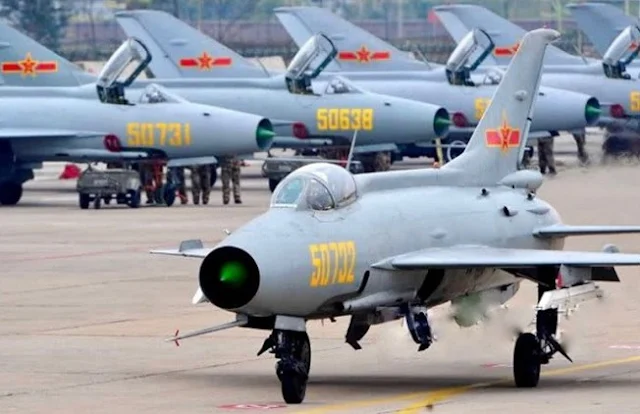 |
| China Disables 500 Chengdu J-7 Fighter Jets at the End of 2023 |
The Global Times reported that the Chinese People's Liberation Army (PLA) will decommission its Chengdu J-7 fighter jets by the end of 2023. China will replace them with the more modern and faster single-engine Chengdu J-10C fighter. Apart from that, China still has twin-engined heavy fighter aircraft from the Shengyang J-11 and J-16 lines.
However, following the decommissioning of the Chengdu J-7 aircraft, the JL-9 (FTC-2000G) derivative and modified trainer aircraft, and the FC-1 fighter (JF-17) will continue to be produced. “China's new aircraft production capacity has increased. The number of J-7 fighter jets remaining in active service is now low,” said Du Wenlong, an expert on the Chinese military, in a Global Times report.
According to some reports, in 2016 the Chinese Air Force was armed with around 500 J-7 fighters of various modifications. This includes trainer aircraft, which are gradually being withdrawn from service.
The publication Military Watch highlights that China's air force is currently receiving more new fighter jets annually than any other country. At the same time, 1 in 5 of China's new aircraft is a 5th generation fighter. Chinese Air Force Chengdu J-7 fighter jet.
There are 11 countries that still operate the Chengdu J-7 fighter, namely Bangladesh, Egypt, Zimbabwe, North Korea, Iran, Myanmar, Namibia, Nigeria, Pakistan, Tanzania and Sri Lanka. China developed the Chengdu J-7 fighter in 1961, after receiving a license from the Soviet Union.
On January 17, 1966, the Chengdu J-7 fighter made its first flight and in 1967 it began to be adopted by the Chinese Air Force. The Chengdu J-7 fighter was continuously upgraded with advanced technology and was produced until 2013. In recent years, the Chengdu J-7 fighter jet has been produced exclusively for export.
Quoted from AeroCorner, the Chengdu J-7 is a light single-engine fighter jet manufactured by Chengdu Aircraft Corporation, licensed from the Mikoyan-Gurevich MiG-21. This aircraft was created to meet the needs of the Chinese People's Liberation Army Air Force (PLAAF).
From 1993 to 2013, more than 2,400 Chengdu J-7 fighters were produced. The export variant of the aircraft was labeled as the F-7, and in May 2013 production of the Chengdu J-7 fighter ended.
The Chengdu J-7 fighter serves as an interceptor and performs ground attack missions. The use of delta wings allows the aircraft to reach a maximum altitude and fly at supersonic speeds.
The Chengdu J-7 fighter is armed with a Type 30-1 2×30 mm cannon (60 rounds per gun). Plus five hard points, four under the wings, and one under the fuselage for carrying various missiles. Among them are air-to-air missiles and guided bombs weighing 50 kg to 500 kg. 55 mm rocket pod (12 rounds) and 90 mm rocket pod (7 rounds).
The Chengdu J-7 fighter is powered by a Liyang Wopen-13F afterburning turbojet engine with a maximum thrust of 9,900 lbf and 14,600 lbf with afterburner.
